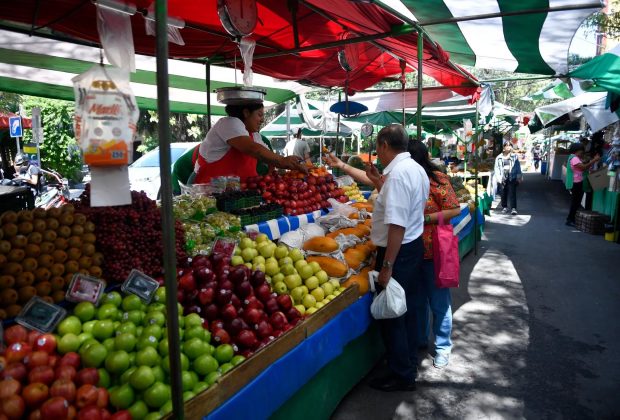The peso’s soaring value means the money that Mexicans in the United States send home doesn’t go as far as it used to.
By J. Edward Moreno | The New York Times | JUL. 31, 2023 | Photo by Claudio Cruz
Most of the money that Antonio Solis makes delivering food on his motorcycle in New York City will eventually make its way to Monterrey, Mexico, where it will pay for his family’s mortgage, his daughter’s college tuition and daily expenses like groceries.
But covering those costs is getting harder. Mr. Solis, who earns about $3,500 a month delivering for apps like DoorDash, used to send about $1,500 monthly. Since the spring, he has had to send more than $2,000 to cover the same expenses, something he does by working longer days.
The culprit is a sharp appreciation of the Mexican peso over the past year, a product of high interest rates and foreign investments in Mexico, among other factors. That means each dollar Mr. Solis sends covers less of the budget back home. He, like hundreds of thousands of other Mexicans abroad, has contributed to the billions of U.S. dollars that flood into Mexico each year — money that families there rely on to make ends meet.
Mexico is the second-biggest receiver of remittances behind India. In 2022, those working abroad, primarily in the United States, sent more than $61 billion to Mexico. The largest portion of that money goes to food and clothes, followed by health care, according to the Wilson Center, a Washington research organization.
Relying on money from the United States means Mexicans are especially sensitive to large swings in its currency like this one. Remittances amounted to 4 percent of the country’s gross domestic product in 2021. Analysts say the falling purchasing power of each dollar sent to Mexico could discourage spending on big-ticket items — like homes or weddings — as families focus on their basic needs.
The value of the peso has climbed about 20 percent against the dollar since last fall, and is now the strongest it has been in about seven years. A dollar currently exchanges to about 16.7 pesos, down from about 20 when Mr. Solis first came to the United States in 2019. Although the amount of remittances in May was up from a year earlier, the spending power of that money declined more than 7 percent when adjusted for the peso’s surge as well as inflation, according to a report from Grupo Financiero BASE, a Mexican financial services firm.
Currencies do not typically jump that sharply. Several factors had to coincide to bring the peso up to its current perch, including rising interest rates and a boom in decisions by U.S. companies to move operations to Mexico.
Countries around the world are trying to get inflation under control. The peso’s value has soared in part because Mexico’s central bank started raising interest rates faster than the U.S. Federal Reserve did.
After a series of increases in Mexico, the gap between the benchmark rates in the countries has widened. The Mexican central bank’s overnight target rate is 11.25 percent, versus a range of 5.25 to 5.5 percent in the United States.
That is one common reason that one currency tends to appreciate compared with another. The rally in the peso is also due to trade policy.
Because of the United States’ fraught relationship with China, investments in Mexico became more attractive, so companies began to move manufacturing there in a practice called near-shoring.
This year, Mexico overtook China as the United States’ top trading partner, and foreign direct investment in Mexico in the first quarter of this year rose nearly 50 percent from a year earlier. That also strengthened the currency.
“It’s really a perfect storm that propped up the peso,” said Diego Marroquín Bitar, a U.S.-Mexican trade expert.
The peso is also rebounding from a particularly low point. It started losing a lot of value in 2015 when Donald J. Trump, who was running for the Republican presidential nomination, began talking of doing away with the North American Free Trade Agreement, said Alejandro Werner, the founder of the Georgetown University Americas Institute. Then the currency plunged in 2020 because of the coronavirus pandemic.
At the peso’s weakest point in recent years, in April 2020, the exchange rate was about 25 for one dollar. At that time, Mr. Solis was struggling to make ends meet, getting less work because of pandemic shutdowns.
“When it was at 25, that was wonderful, but there wasn’t any work,” he said.
Now that the peso is stronger, analysts expect that remittances will moderate. Though workers will have to send more dollars to pay for the same essential expenses — like Mr. Solis’s tuition payments for his daughter — they are likely to pass up leisure spending or investments until their dollars can go further.
“People will not invest now,” said Dilip Ratha, a remittances economist at the World Bank. “They will wait for things to be cheaper later.”
A stronger peso could hurt Mexican exports, which play a big role in the U.S. automotive industry and U.S. agriculture. Mexican goods would be less competitive because they would be more expensive.
But “it’s not a game changer” for exports yet, said Luis Torres, an economist at the Federal Reserve Bank of Dallas. The United States-Mexico-Canada Agreement, which replaced NAFTA in 2020, and near-shoring keep Mexican goods competitive, he noted.
For people like Mr. Solis, though, a dollar with less purchasing power is the difference between putting food on the table or not. And fast inflation in the United States has added to the challenge of covering those costs.
“It’s complicated because your family has to eat,” Mr. Solis said. “If it goes up any more, it would be catastrophic.







